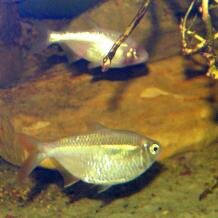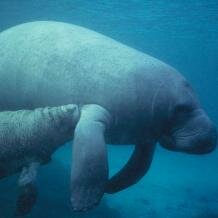Topic: Lateral line system in fish and other animals
Some cavefish are completely blind, so how do they manage to navigate through their environment with astonishing ease?
Our hearing is the most familiar example of a sensory system that depends on changes in pressure, as sound is transmitted through air. Whilst ears are rampantly convergent, especially in insects, other pressure-sensitive systems show fascinating examples of convergence as well (including seismic communication). Underwater, sound is virtually the same as stimulation by vibration and a number of aquatic animals have evolved a sense organ that is extremely sensitive to pressure changes transmitted through water. This so-called lateral line system is best known from the fish (and the descendant amphibians), but analogues have evolved in cephalopods, in an intriguingly separate way in some crustaceans and even in a few aquatic mammals. What all these hydrodynamic detection systems have in common is that changes in water pressure bend tiny hairs, which triggers a nervous signal.
Fish lateral line system
Structure and function
 The lateral line system of fish has been the subject of extensive research. It consists of rows of mechanosensory cells that run around the head and along the side of the body, where they are often visible as a faint line. The receptors are called neuromasts and composed of hair cells embedded in a jelly-like cupula, which is deflected by water movements. While in some fish the neuromasts lie on the surface, they are located in canals in most teleosts and elasmobranchs. Not only is this system extremely sensitive, but it also shows some remarkable parallels to the eye. It can form a sort of hydrodynamic ‘image’, apparently interpreting a complex array of stimuli that are received on the side of the fish’s body (although, presumably, there is no way to focus this image).
The lateral line system of fish has been the subject of extensive research. It consists of rows of mechanosensory cells that run around the head and along the side of the body, where they are often visible as a faint line. The receptors are called neuromasts and composed of hair cells embedded in a jelly-like cupula, which is deflected by water movements. While in some fish the neuromasts lie on the surface, they are located in canals in most teleosts and elasmobranchs. Not only is this system extremely sensitive, but it also shows some remarkable parallels to the eye. It can form a sort of hydrodynamic ‘image’, apparently interpreting a complex array of stimuli that are received on the side of the fish’s body (although, presumably, there is no way to focus this image).
 The lateral line is highly versatile, being employed in diverse tasks such as schooling (helping to explain the remarkable synchronous movements), tracking and detection of prey and predators and even sexual communication (as in the vibrational signals that are exchanged between male and female himé salmon Oncorhynchus nerka and elicit spawning behaviour). Furthermore, the electroreceptors of sharks and other electroreceptive fish are derived from the lateral line system. It is thus central to the sensory world of fish.
The lateral line is highly versatile, being employed in diverse tasks such as schooling (helping to explain the remarkable synchronous movements), tracking and detection of prey and predators and even sexual communication (as in the vibrational signals that are exchanged between male and female himé salmon Oncorhynchus nerka and elicit spawning behaviour). Furthermore, the electroreceptors of sharks and other electroreceptive fish are derived from the lateral line system. It is thus central to the sensory world of fish.
Although the extraordinary sensitivity of this system has long been appreciated, building an artificial analogue has, perhaps surprisingly, only recently been contemplated. In part, this may be because of the use of sonar, which is, of course, the technological equivalent of echolocation. Nevertheless, the development of artificial lateral lines has considerable potential and represents another example of the possible importance of evolutionary convergence in technology.
Blind cavefish
The role of the lateral line has been investigated in blindfolded fish, but probably the best point of reference is the Mexican tetra (Astyanax mexicanus).  This freshwater fish occurs in two forms, a normal form with well-developed eyes and a blind cave form. Although additional sensory modalities (such as olfaction) cannot be ruled out, there is little doubt that this fish lives in a sensory world that is very largely dictated by the lateral line system. At first this seems a daunting prospect, because the effective range of sensitivity of the system (about 5 cm) is hundreds of times smaller than the fish’s effective ecological range (about 30 m). However, experiments have revealed that the cavefish constructs a spatial map (and by implication a cognitive map) that recognises landmarks and their size as well as possibly their shape. Counter-intuitively, when this fish enters a novel environment, it actually accelerates! This probably serves to enhance the sensitivity of the lateral line system by increasing the pressure differential.
This freshwater fish occurs in two forms, a normal form with well-developed eyes and a blind cave form. Although additional sensory modalities (such as olfaction) cannot be ruled out, there is little doubt that this fish lives in a sensory world that is very largely dictated by the lateral line system. At first this seems a daunting prospect, because the effective range of sensitivity of the system (about 5 cm) is hundreds of times smaller than the fish’s effective ecological range (about 30 m). However, experiments have revealed that the cavefish constructs a spatial map (and by implication a cognitive map) that recognises landmarks and their size as well as possibly their shape. Counter-intuitively, when this fish enters a novel environment, it actually accelerates! This probably serves to enhance the sensitivity of the lateral line system by increasing the pressure differential.
What is also remarkable is that, at least in the blind cavefish, this sensory system shows a pronounced laterality. When the fish encounters novel objects, it shows a preference to use the right hand side (although this abates as the fish becomes familiarised). Laterality in eye use is very widespread, with examples from groups as diverse as birds, dolphins, and octopus, and probably convergent.
Lateral line analogues in other animals
Cephalopods
 The most striking analogy to the lateral line system of fish is found in cephalopods such as cuttlefish, squid and octopuses, where the head and arms bear similar lines of ciliated epidermal cells. Electrophysiological recordings from these lines in the common cuttlefish (Sepia officinalis) and the brief squid (Lolliguncula brevis) identified them “as an invertebrate analogue to the mechanoreceptive lateral lines of fish and aquatic amphibians and thus as another example of convergent evolution between a sophisticated cephalopod and vertebrate sensory system” (Budelmann and Bleckmann 1988, Journal of Comparative Physiology A, vol. 164, p. 1). Unfortunately, not much is known about the functional similarities with the fish, but it has been suggested that the cephalopod lateral line analogue could serve to detect predators and prey, localise objects and maybe even assist in schooling behaviour when vision is limited. This would seem to be a productive research area, not only because of the other striking convergences in the sensory systems between cephalopods and vertebrates (e.g. balancing reflex and camera eyes), but also because the cephalopods are more versatile in certain respects (e.g. chromatophores).
The most striking analogy to the lateral line system of fish is found in cephalopods such as cuttlefish, squid and octopuses, where the head and arms bear similar lines of ciliated epidermal cells. Electrophysiological recordings from these lines in the common cuttlefish (Sepia officinalis) and the brief squid (Lolliguncula brevis) identified them “as an invertebrate analogue to the mechanoreceptive lateral lines of fish and aquatic amphibians and thus as another example of convergent evolution between a sophisticated cephalopod and vertebrate sensory system” (Budelmann and Bleckmann 1988, Journal of Comparative Physiology A, vol. 164, p. 1). Unfortunately, not much is known about the functional similarities with the fish, but it has been suggested that the cephalopod lateral line analogue could serve to detect predators and prey, localise objects and maybe even assist in schooling behaviour when vision is limited. This would seem to be a productive research area, not only because of the other striking convergences in the sensory systems between cephalopods and vertebrates (e.g. balancing reflex and camera eyes), but also because the cephalopods are more versatile in certain respects (e.g. chromatophores).
Crustaceans
 A rather remarkable convergence to the fish lateral line is found in some pelagic decapod crustaceans. They do not possess rows of mechanosensory cells on their body, but have cleverly employed their antennae for this purpose. A number of species in the shrimp families Sergestidae and Penaeidae have long trailing flagella on the second pair of antennae that are held parallel to the body at some distance. Their tips are equipped with curved setae that form tubes containing mechanoreceptors at regular intervals. Some mechanical properties of this system are remarkably similar to those of fish lateral lines and it was concluded that “these crustaceans have two ‘lateral lines’ widely spaced from the animal’s body and mechanically independent of the body” (Denton and Gray 1985, Proceedings of the Royal Society of London Series B, vol. 226, p. 249).
A rather remarkable convergence to the fish lateral line is found in some pelagic decapod crustaceans. They do not possess rows of mechanosensory cells on their body, but have cleverly employed their antennae for this purpose. A number of species in the shrimp families Sergestidae and Penaeidae have long trailing flagella on the second pair of antennae that are held parallel to the body at some distance. Their tips are equipped with curved setae that form tubes containing mechanoreceptors at regular intervals. Some mechanical properties of this system are remarkably similar to those of fish lateral lines and it was concluded that “these crustaceans have two ‘lateral lines’ widely spaced from the animal’s body and mechanically independent of the body” (Denton and Gray 1985, Proceedings of the Royal Society of London Series B, vol. 226, p. 249).
Mammals
 One would not necessarily expect to find an equivalent to the lateral line system in mammals, but, intriguingly, such do occur.
One would not necessarily expect to find an equivalent to the lateral line system in mammals, but, intriguingly, such do occur.  In the aquatic manatees (genus Trichechus), the postcranial body bears tactile hairs (resembling the mechanosensory hairs of naked mole rats), and this arrangement has been compared to the fish lateral line. As manatees have poor visual capacities, such a system would be useful in the turbid waters they inhabit. Similarly, the role of the whiskers in harbour seals (Phoca vitulina) is now known to include the detection of minute water movements and so serve as a hydrodynamic receptor system (although it seems to be less sensitive than the fish equivalent). Finally in the semi-aquatic desmans, close relatives of the fossorial moles (which excel in tactile sensitivity with their Eimer’s organs) the snout bears tiny hairs that are similar to the neuromasts in the lateral line system of fish.
In the aquatic manatees (genus Trichechus), the postcranial body bears tactile hairs (resembling the mechanosensory hairs of naked mole rats), and this arrangement has been compared to the fish lateral line. As manatees have poor visual capacities, such a system would be useful in the turbid waters they inhabit. Similarly, the role of the whiskers in harbour seals (Phoca vitulina) is now known to include the detection of minute water movements and so serve as a hydrodynamic receptor system (although it seems to be less sensitive than the fish equivalent). Finally in the semi-aquatic desmans, close relatives of the fossorial moles (which excel in tactile sensitivity with their Eimer’s organs) the snout bears tiny hairs that are similar to the neuromasts in the lateral line system of fish.
Cite this web page
Map of Life - "Lateral line system in fish and other animals"
https://mapoflife.org/topics/topic_443_lateral-line-system-in-fish-and-other-animals/
March 3, 2021

